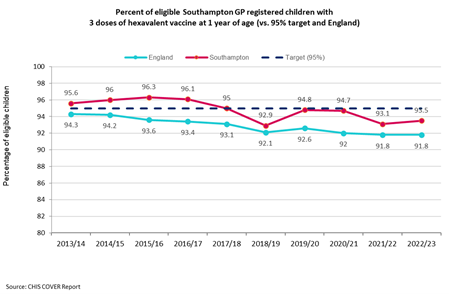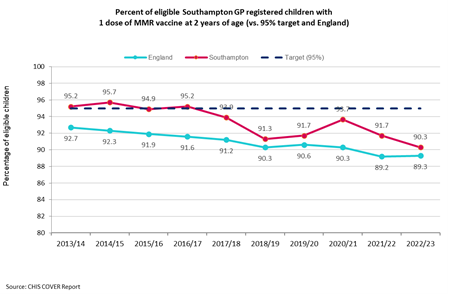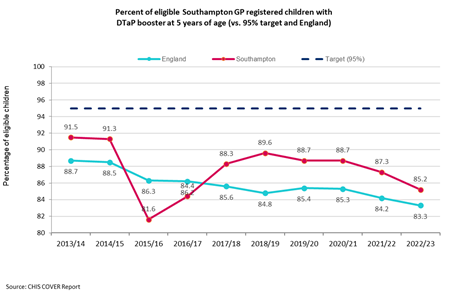
Childhood immunisations
 Childhood immunisations
Childhood immunisations
Between 4 and 5 million deaths are prevented globally each year through immunisation programmes making it one of the most straightforward, successful and cost-effective public health interventions. Children that are immunised are protected from infectious diseases which can cause serious illness or disability and, in some cases, can be fatal. Maintaining high coverage rates is extremely important to help avoid outbreaks of vaccine-preventable diseases, avoid increasing numbers of patients requiring health services and to reduce poor health outcomes including mortality. Vaccines also protect our economy and our public services from the disruption and economic loss of an outbreak or pandemic. Vaccinations will also help reduce use of antibiotics and the growing issue of antimicrobial resistance.
Globally childhood vaccination programmes have been a huge success. However, high immunisation uptake is required to protect as many of the eligible population as possible. For highly infectious diseases such as measles, the World Health Organisation (WHO) recommends an uptake of 95% or greater for population level or herd immunity ensuring those that can’t be vaccinated (for example children under 1 year of age) are protected by those around them. It is concerning that uptake in childhood immunisations in Southampton and England has been steadily decreasing for some time. This decline started prior to the COVID-19 pandemic, the coverage of many key immunisations is now significantly lower than the WHO target of 95%. There is an increasing risk of a resurgence in vaccine preventable diseases as coverage continues to drop.
In Southampton we focus on five key uptake indicators for three routine childhood vaccines:
- 3 doses of Hexavalent (6-in-1) vaccine at 1 year of age
- 1 dose of MMR vaccine at 2 years of age
- 1 dose of MMR vaccine at 5 years of age
- 2 doses of MMR vaccine at 5 years if age
- DTaP (3-in-1 or Td/IPV) booster at 5 years of age
More information can be found on the NHS page on vaccinations and when to have them.
Detailed analyses and insight on childhood immunisations in Southampton can be found in the childhood immunisation strengths and needs assessment below.
Hexavalent (6-in-1) vaccine
The hexavalent vaccine (also known as 6-in-1 or DTaP IPV Hib) helps protect babies against 6 serious illnesses; diphtheria, hepatitis B, Hib (Haemophilus influenza type b), polio, tetanus and whooping cough. These vaccinations are given to babies at 8, 12 and 16 weeks. They are most effective when received on time, however they can be given up to the age of 10 years. While England has not achieved 95% uptake for the hexavalent vaccine (3 doses by 1 year of age) since records began in 2013/14, Southampton was regularly achieving higher than 95% until 2017/18. Since then Southampton has missed the target for 5 consecutive years. In 2019/20 and 2020/21 during the COVID-19 pandemic Southampton narrowly missed the target due to increased uptake. In Southampton, uptake has been consistently higher than England each year, however Southampton's uptake in 2022/23 (93.5%) was 2.8 percentage points lower than 2015/16. Both England and Southampton have seen an overall decline in uptake.
While England has not achieved 95% uptake for the hexavalent vaccine (3 doses by 1 year of age) since records began in 2013/14, Southampton was regularly achieving higher than 95% until 2017/18. Since then Southampton has missed the target for 5 consecutive years. In 2019/20 and 2020/21 during the COVID-19 pandemic Southampton narrowly missed the target due to increased uptake. In Southampton, uptake has been consistently higher than England each year, however Southampton's uptake in 2022/23 (93.5%) was 2.8 percentage points lower than 2015/16. Both England and Southampton have seen an overall decline in uptake.
More information can be found on the NHS page on the 6-in-1 vaccine.
Detailed analyses and insight on childhood immunisations in Southampton can be found in the childhood immunisation strengths and needs assessment below.
MMR vaccine
The MMR vaccine protects against 3 serious illnesses; measles, mumps and rubella (German measles). These are highly infectious illnesses and can spread easily between unvaccinated people. The best protection from theses illnesses comes from having two doses of the MMR vaccine during childhood (at 1 year of age and at 3 years and 4 months).
The MMR vaccine has been the subject of unfounded controversy and misinformation, which may explain part of its declining uptake across England and Southampton. Uptake for Southampton and England is now below 95% for all three MMR measures:
 1 dose of MMR vaccine at 2 years of age
1 dose of MMR vaccine at 2 years of age- 1 dose of MMR vaccine at 5 years of age
- 2 doses of MMR vaccine at 5 years if age
For 1 dose at 3 years of age, Southampton was achieving 95% coverage in 2013/14 and 2014/15. Since then it has declined faster than the England average, except for a slight resurgence during the COVID-19 pandemic. Southampton's uptake was 5.4 percentage points lower in 2022/23 than it was 8 years prior. The England average has been consistently below Southampton's uptake and didn't have the same increase in uptake during the COVID-19 pandemic.
In 2022/23, the percentage of eligible children receiving 2 doses of the MMR vaccine by their 5th birthday was below 90% for England (84.5%) and Southampton (85.7%). The WHO target for herd immunity is 95%, rates below 90% are a cause for concern. In 2022/23 the rate of decline in uptake increased in Southampton and England. Uptake in Southampton dropped by 2.4 percentage points compared to 2021/22, Southampton's biggest single year decrease since records began in 2013/14.
More information can be found on the NHS page on the MMR vaccine.
Detailed analyses and insight on childhood immunisations in Southampton can be found in the childhood immunisation strengths and needs assessment below.
DTaP vaccine
The DTaP vaccine (also called the Td/IPV or 3-in-1 teenage booster) helps protect against tetanus, diphtheria and polio by boosting the protection provided by the hexavalent (6-in-1) vaccine. It is given to older children in school year 9 (13 or 14 years old) and to people at higher risk of tetanus, diphtheria or polio.
The number of children receiving this booster in England and Southampton has been below the 95% target since records began. Both England and Southampton have seen a decline in uptakes, both are now below 90%. In 2022/23 England had an uptake rate of 83.3%, significantly lower than the 95% target and its lowest rate since records began. Over the last 3 years Southampton's rate has declined faster than England to a current rate of 85.2%. This is 6.3 percentage points lower than it was 9 years earlier.
More information can be found on the NHS page on the DTaP vaccine.
Detailed analyses and insight on childhood immunisations in Southampton can be found in the childhood immunisation strengths and needs assessment below.
Resources
Childhood immunisations public survey
As part of our Childhood Immunisation Needs Assessment, Southampton City Council conducted a survey with residents of Southampton on Childhood Immunisations. The aim was to explore views and experiences of routine childhood vaccinations offered to children under five years of age. The results of this survey will help us to gather views and inform how services are delivered.
Health Protection overview
Data and insights on a range of Health Protection indicators, focused on five main areas: Gastrointestinal infections, Immunisations and childhood vaccine preventable diseases, respiratory infections, hepatitis, sexually transmitted infections and HIV. We also monitor these additional Health Protection indicators: acute Lyme disease, air pollution mortality, antibiotic prescription, excess winter deaths, scarlet fever.
NHS vaccinations
Webpage form the NHS giving information on each vaccine, what they protect against and when they should be received.
Last updated: 15 March 2024
